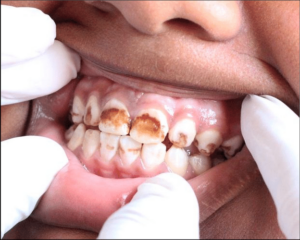Fluoride-Containing Voriconazole Can Cause Arthritis, Case Study Concludes

A patient with COVID-19 related aspergillosis of the lungs who was placed on the anti-fungal drug voriconazole has developed arthritis from the fluoride-containing drug, according to a new report from physicians at the Westmead Hospital in Australia.
Whole-body bone scans of the patient, a male in his early 60’s who had been hospitalized for five months for COVID infection, showed that the man’s shoulders and wrists were particularly affected by inflammatory polyarthritis, according to the report in Proceedings of Singapore Healthcare.
“Voriconazole contains fluoride, which can be deposited within the bony matrix, causing musculoskeletal symptoms,” report the authors.
“The constellation of widespread pain, polyarthritis with upper limb predominance occurring eight weeks while on voriconazole and nearly 16 weeks after initial COVID-19 infection, presence of periostitis and raised serum ALP and fluoride support the diagnosis of voriconazole-induced musculoskeletal event instead of post COVID-19 reactive arthritis,” conclude the authors.
Clinical symptoms resolved four weeks after cessation of the voriconazole treatment, they report.
A 2014 study of patients given voriconazole for fungal infections at St. Joseph Mercy Hospital in Michigan, found that “high plasma fluoride concentration coupled with skeletal pain among patients who are on long-term voriconazole therapy is highly suggestive of periostitis. Obtaining a plasma fluoride level may be a cost-effective first-line alternative to obtaining a bone scan for patients who have skeletal pain and are unable to afford the cost of a bone scan or for institutions where nuclear imaging is not readily accessible.”
Sources:
–https://doi.org/10.1177/20101058221149575
-https://www.jwatch.org/na36077/2014/10/23/voriconazole-fluoride-levels-and-periostitis
The FAN webpage with a list of fifteen studies on this topic can be found at this link: https://fluoridealert.org/tag/voriconazole/
Mexican Study Finds Children With Low BMI Are More Susceptible to Severe Dental Fluorosis

A study of over 500 children, aged 8-12 years, from Oaxaca, México, who drank water with mean fluoride concentrations of 1.39 ppm in tap water and 0.32 ppm in bottled water, found that children with a low Body Mass Index (BMI) score, which researchers attributed to poor nutritional status, showed more severe development of dental fluorosis.
“Children living in areas with higher fluoride concentrations in the tap water and bottled water were more likely to have dental fluorosis in the severe categories,” reported the authors.
The authors also stated that little is known about the importance of fluoride concentration in bottle water on the prevalence of dental fluorosis, adding, “In low-income countries bottled water use has a different connotation than in developed countries, because the tap water in underdeveloped regions may not be suitable for drinking.”
They also pointed out that fluoride levels are often not reported or included in labeling.
“Concern about a lack of labeling on bottled water is evident in the United States and other countries. The public should also have easy access to information regarding the fluoride levels in the tap water they receive at home. Fluorosis is an irreversible condition, and its treatment is expensive. In severe cases of fluorosis, a full crown reconstruction is required, which is a time-consuming and costly procedure that is often beyond the reach of low-income people,” noted the authors.
“The possible relationship between undernutrition and fluorosis and the concurrence of both conditions in poor countries is of concern. Underweight children may experience the negative effects of fluoride in doses that may be safe for well-nourished children. A review of groundwater fluoride studies in sub-Saharan Africa suggested that the people most affected by fluorosis were poor and living in rural areas, as were the Mexican children in the present study,” concluded the authors.
Source: https://doi.org/10.3389/froh.2023.1187463
Pro-Fluoridation Canadian Investigators Ignore Evidence, Call Fluoride’s Neurotoxicity ‘Misinformation’

In the latest academic attempt to understand the impact of social media posts on the public’s disaffection with fluoride, dental and digital investigators from several Canadian universities have concluded, “Public concerns toward a healthy lifestyle, including the adoption of natural and organic cosmetics, seem to be the main motivation of the recent increase of “fluoride-free” tweets, which can be boosted by the propagation of fluoride falsehoods.”
Reporting in the Journal of Medical Internet Research on June 23, they write, “[M]isinformation that fluoride causes neurological disorders has flooded the internet with erroneous beliefs on the poisoning capacity of fluoride. This spread of misinformation has contributed to a public refusal to use fluoride to control dental caries.
They cite only two reports that downplay fluoride’s neurotoxicity, ignoring a large body of evidence that found prenatal exposure to fluoride at levels used in the fluoridation of community water systems is associated with a marked decline in intelligence as measured in IQ tests.
As is often the case in these academic reports on social media, the authors withhold needed information from the public while heralding the need for a more informed population.
“Certainly, the adoption of reliable web-based health information by users can enhance individual and shared decision-making, thus contributing to better health care outcomes. In this context, government agencies and organizations should be aware of the importance of investments in measures designed to improve the acquisition of information by the population,” they conclude.
Source: https://doi.org/10.2196/44586
Red Sea Coast of Saudi Arabia Found to Have High Fluoride Groundwater

The Saudi Arabian Red Sea coast can be added to the list of areas with fluoride contaminated groundwater, according to a new report from King Saud University.
‘Nitrate, fluoride, and HMs can enter groundwater through different natural and anthropogenic artificial [sources]. Drinking water with excessive nitrate, fluoride, and HMs [heavy metals] can cause side effects including tooth decay, fluorosis, arthritis, neurological problems, thyroid disease, cancer, infertility, hypertension, and methemoglobinemia,” write the authors.
They note that water supplies are limited in the Kingdom of Saudi Arabia, with shallow aquifers along coastal regions.
“Nitrate and fluoride concentrations ranged from 1.4 to 560 mg/l (average: 122.74 mg/l) and 0.002 to 2.40 mg/l (average: 0.70), respectively. The highest fluoride and nitrate contents in water samples were observed …. along the coastal area, while the lowest contents were reported in … the northeast corner and … in the northern side, respectively. 66.66 % (32 out of 48) of the nitrate and in accordance with WHO recommendations for drinking water, 12.50 % (6 out of 48) of the fluoride samples exceed the acceptable limits of 50 mg/l and 1.5 mg/l, respectively, reported the investigators May 30 in Marine Pollution Bulletin.
Source: https://doi.org/10.1016/j.marpolbul.2023.115080
Zebra Fish Developed as Model Organism for Chronic Kidney Disease (CKDu)

Chronic and acute exposure of the zebra fish, Danio rerio, to fluoride and other toxins in drinking water has led to the discovery of several perturbations of the animal’s cell structures, gene expression, diversity and richness of the gut bacteria, and metabolic chemicals critical to renal function.
The investigators from Chinese and Sri Lankan universities hope to develop the zebrafish as a model for studying the poorly understood Chronic Kidney Disease of unknown cause (CKDu) that afflicts many in Sri Lanka, causing premature death.
“CKDu frequently developed with progressive kidney damage and is evidenced by the structural and gradual decline of functional irreversible abnormalities, which is clinically defined as a sustained loss of renal function and determined as a fall in glomerular filtration rate (GFR) < 60 mL/min or the presence of albuminuria,’ they write.
“Chronic exposure influenced the body weight of both genders of adult fish and induced kidney damage by histopathological analyses. Furthermore, the exposure significantly disturbed differential expression genes (DEGs), diversity and richness of gut microbiota, and critical metabolites related to renal functions. The transcriptomic analysis revealed that kidney-related DEGs were linked with renal cell carcinoma, proximal tubule bicarbonate reclamation, calcium signaling pathway, and HIF-1 signaling pathway. The significantly disrupted intestinal microbiota was closely related to the environmental factors and H&E [hematoxylin and eosin stain] score, which demonstrated the mechanisms of kidney risks,” they report in Environmental Pollution June 5.
In addition to studying fluoride, they tested water hardness and fluoride, heavy metals, microcystin-LR [a toxin from cyanobacteria], and their combined exposure.
Source: https://doi.org/10.1016/j.envpol.2023.121967
Pro-Fluoridation Group Worried Over FAN Lawsuit Against EPA

An organization that has long defended water fluoridation and “is well known for being a pro-industry group” according to Wikipedia, has posted a commentary expressing grave concerns over the ramifications of FAN’s lawsuit against the Environmental Protection Agency under the Toxic Substances Control Act.
“The outcome of a court case involving fluoridation could have serious ramifications for EPA rules in the years to come,” writes Susan Goldhaber on the American Council for Science and Health website May 30.
While making attempts to raise doubt about the recent National Toxicology Program report that concluded fluoride in drinking water has a neurotoxic effect on the developing brains of children, Goldhaber is particularly concerned that the lawsuit could set legal precedent that would harm the interests of chemical industries.
“The outcome of the court case could have implications far beyond water fluoridation,” she writes.
“Suppose EPA stays wedded to correlation, especially in using social science constructs, such as IQ. In that case, they risk the courts failing to give them the same broad latitude in interpreting scientific studies that have existed in the past,’ she concludes.
Source: https://www.acsh.org/news/2023/05/30/fluoride-controversy-never-dies-17093
Norwegian County Found to Have High Levels of Fluoride in Drinking Water

A recent report in Science of the Total Environment that surveyed 27 water supplies across Norway found that the supply in Troms and Finmark county in the north had a fluoride level of 5.0 mg/L.
The authors found three water supplies with fluoride levels above 1.5 mg/L.
“The drinking water regulations’ limit for fluoride is 1.5 mg/L. Fluorine is released to groundwater by weathering or anion exchange at high pH. Granites and granitic gneisses are risk rocks for fluoride, and up to 8.26 mg/L have previously been measured in groundwater samples from a crystalline bedrock aquifer in southwestern Norway. A sporadic occurrence of dental fluorosis in children and skeletal fluorosis in cattle using bedrock groundwater was noticed in south and western Norway. Groundwater with a low calcium content and a high pH (pH > 8) often contains increased levels of fluoride. In this study, the highest median concentration of fluoride (5.0 mg/L) was measured at waterworks no. 3 in Troms and Finnmark county. The waterworks is located near the coast in an area with bedrock
of mica-gneiss and –schist, metasandstone, and amphibolite,” report the authors from Norwegian University of Life Science and the Norwegian Institute of Public Health.
They concluded, “The results from this work showed that marine salts and local conditions can be decisive for fluoride concentration in groundwater from bedrock aquifers, where the highest concentration of fluoride (5.3 mg/L) was measured in coastal areas. A significant positive correlation between fluoride and sodium (p=0.04) in groundwater from bedrock indicates that the concentration of fluoride in groundwater in near-coastal areas is more affected by sea salts in precipitation than by bedrock geology.”
